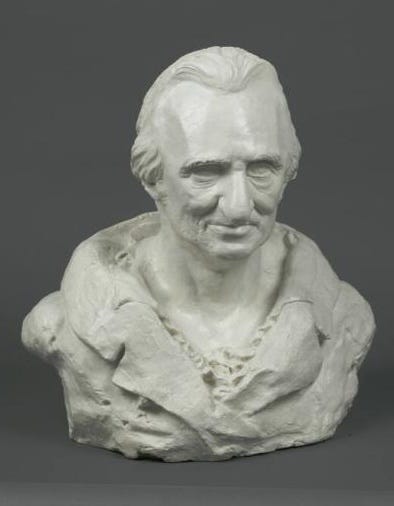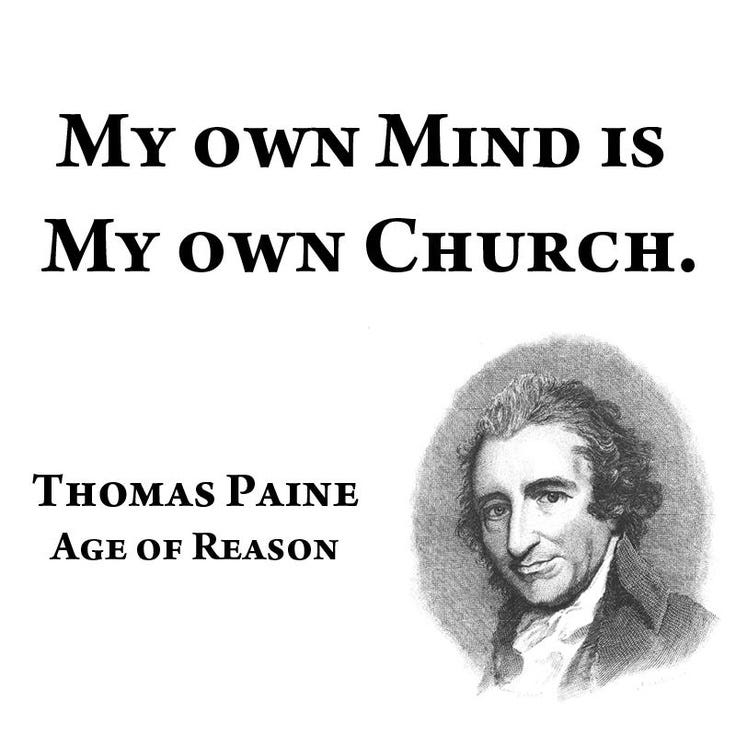FINDING THOMAS PAINE.
A PERSONAL TALE.
How did the author this Substack become focused on Thomas Paine - and his followers ? Or alternatively, “how did Paine find him?” My relationship or connection to Thomas Paine may be something of a question-mark for most of you. A video-chat conversation last evening with a friend and colleague reminded me that some explanation may be of interest to readers. As this blog has grown, there are more and more members who don’t know me personally. So, as briefly as possible:
Without exaggeration, it was a “beam of light” moment sometime around 1981, standing in a second-floor jewelry arts atelier, near a tall window that overlooked semi-tropical, sunny, and bustling State Street, Santa Barbara, CA. How it came to be that I was reading Thomas Paine’s Age of Reason (1794) that day is lost to my memory. But there I was, standing in that brightly lit room with a copy of Age of Reason open before my eyes. As I read Paine’s introductory remarks the experience suddenly shifted. One moment I was reading the book line-by-line - as one commonly reads a book - and the next instant I heard a voice declaiming the words. It startled and dizzied me a bit; a bright, cool chill of adrenaline lit my body and mind. It was as if I knew or recognized the voice. It was as if Paine was speaking the words directly to me.
[Bust of Thomas Paine by his roommate, American artist John Wesley Jarvis]
It was a stand-alone moment and as I read deeper into Paine’s account, in touch with what felt like Paine’s voice, my fascination grew. A certainty arose in my mind and every cell of my body that I MUST learn more about this person.
Lest you misunderstand, little if anything in Paine’s book was new or revolutionary to my ears and eyes at that time. My exposure to deism and a textual critical approach to the Bible - Paine’s subject in Age of Reason - was already somewhat well-developed. This area of study had been a life-long pursuit that continues to this day. The content was ribald and wonderful - it must be read to be appreciated. But the content was not shocking. What was shocking was the sensation of hearing that voice and the powerful impressions and motivations that arose from the experience.
Definition: a critical textual approach to the Bible employs methods like textual criticism to determine the most accurate original wording of biblical texts. It also encompasses broader historical-critical methods like examining the text’s historical context, sources, form criticism, translation issues, redaction criticism, social-scientific approaches, and an examination of the transmission process. Rather than define all of those, you can look them up if you’re curious. Paine’s Age of Reason is an early historic example of just such an exploration.
It was a “beam of light,” but also a turning point; a fork in the road.
The thought that “I must learn every thing possible about this person” set me on an extraordinary adventure; perhaps a pilgrimage or a trial. In the early days, everything was by hand and rotary phone. There WERE no computers, cell phones, photocopy machines … all of the techno-tools we take for granted today. I found a huge door-stopper of a reference book at the main branch of a library that held a tiny entry, a phone number that led me to the first of many mentors, Florence Stapleton; the director of a museum, now defunct, dedicated to Thomas Paine. She understood immediately and through her kindness and skill I became successively a museum trustee, officer, editor, publisher, and association historian of what was then the most prominent historical association involved with Thomas Paine studies. Readers of this blog will know that this particular association fell prey to adverse and adversarial leadership that led to accusations and findings of misconduct and misappropriation. That tale has been recounted elsewhere in my blog history, but “long story short,” good fortune and influences encouraged me to resign, report, and step up rather than down. The many fine historians and broadcasters for whose influence I am deeply grateful during that period include colleagues and friends Prof. Harvey J. Kaye, Dr. Eric Foner, the late Peter Jennings, Lewis Lapham, Brian Lamb, Dr. Jack Fruchtman, Robert Singletary, the late Mike Wallace, Andy Rooney, and Drs. Marvin Edelman, Francesco Cardozo, and others. And I mustn’t omit the fundamental and perhaps greatest influence; my fine and intelligent parents. These and others inspired me to return to university life. I obtained a doctorate … in history, of course … and published a little. Along the way, I discovered that history was what I’d been looking for in all my explorations and adventures in life.
There is no simple explanation for the experience. Was it the working of my own mind and a quantum sub-total of all my learning and explorations up to that time? Perhaps and even probably. But the impression was overwhelming and striking. I can still see that moment in my mind’s eye. Was it a matrix of Thomas Paine speaking out of the universal cosmic field of energy? Quantum entanglement? Dunno.
So there you have a VERY abbreviated account of a much longer tale, but Paine’s Age of Reason opened a door of perception and a mechanism of change in the direction of my life. It is now a 45 year quest.
Paine finished Part One of Age of Reason just as he was arrested and taken to the dungeon of the Luxembourg Fortress at the peak of the French Revolution. He managed to pass off the manuscript to one of his friends, the diplomat and poet Joel Barlow, at the moment he was arrested and taken from his home outside Paris. Part Two of Age of Reason was written in prison and shortly after his release from captivity. Paine himself stated the reason that he wrote Age of Reason:
“IT has been my intention, for several years past, to publish my thoughts upon religion. I am well aware of the difficulties that attend the subject, and from that consideration, had reserved it to a more advanced period of life. I intended it to be the last offering I should make to my fellow-citizens of all nations, and that at a time when the purity of the motive that induced me to it, could not admit of a question, even by those who might disapprove the work.
The circumstance that has now taken place in France of the total abolition of the whole national order of priesthood, and of everything appertaining to compulsive systems of religion, and compulsive articles of faith, has not only precipitated my intention, but rendered a work of this kind exceedingly necessary, lest in the general wreck of superstition, of false systems of government, and false theology, we lose sight of morality, of humanity, and of the theology that is true.
As several of my colleagues and others of my fellow-citizens of France have given me the example of making their voluntary and individual profession of faith, I also will make mine; and I do this with all that sincerity and frankness with which the mind of man communicates with itself.”
What Paine knew, he only implied: “I intended it to be the last offering I should make to my fellow-citizens of all nations, and that at a time when the purity of the motive that induced me to it, could not admit of a question, even by those who might disapprove the work.” He knew his arrest and probable execution were imminent. They were.
Do yourself a favor and read Age of Reason. Harvey J. Kaye’s bio of Paine is still probably the most accessible “life” of Paine and Paine’s life was one of the most adventurous in history. Francis Chiu’s book on Paine’s Rights of Man may be the single best work on Paine’s ideas and it too includes some survey of his bio. There are many other suggestions I can and will make.
But how about YOU? What questions do you have? Is anything you’d like discussed or covered? Just post your questions or comments in the comments section below.
If you enjoy 21st Century Restoration, you can help just by liking the post (it’s the little heart at bottom of the page), commenting, or SHARING (there’s a button just below). It’s free to subscribe to this page. Just sign-up to Substack. it’s a great platform … no surveillance, no sharing of your information, and LOTS of good writers and publishers — some of the best. You can volunteer a paid subscription and THANK YOU to the readers who have done so. Or you can simply leave a donation great or small - it all helps - at Buy Me a Coffee, here.



